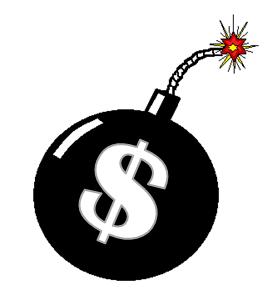By Rick Manning
Both political parties love to tell the story about how the U.S. government balanced its budget during the 1990s, with Bill Clinton and then Speaker Newt Gingrich sharing the credit. There is only one problem with this story — the national debt kept going up significantly every year throughout the 1990s, so it really isn’t true.
In fact, the national debt went from $4.4 Trillion at the end of 1993 to almost $5.7 Trillion at the end of 2000, U.S. Treasury data shows, a 28 percent increase in the debt over this time when our nation supposedly was running a balanced budget.
The reason for the confusion is that the reported budget deficit/surplus does not take into account new debt being incurred by the Social Security and Medicare Trust Funds and other government loan programs. So, when the budget appeared to have gone down by $69 billion in 1998, the national debt increased by $109 billion, similarly in 1999, the budget surplus appeared to be $126 billion, the actual national debt rose from just under $5.5 trillion to just over $5.6 trillion.
You don’t even have to take my word for it, just go to the White House Office of Management and Budget Historical Budget tables and look it up for yourself. Table one provides the numbers which are used to calculate what is commonly known as the budget deficit or surplus and Table seven provides the annual growth or decline of the federal debt.
When the numbers are reviewed, it is shocking to learn that the last time the national debt has gone down was 1957, when Dwight D. Eisenhower was President 59 years ago.
That is the ugly truth about our national debt, while it is correlated to the budget deficit, it has not gone down, and with a current debt of approximately $19.6 trillion, the only thing saving America from being overrun by interest payments on the debt are the historically low interest rates that are being charged to fund it and the dollar’s status as the world’s reserve currency.
The Congressional Budget Office reported in its January 2016 Summary on Budget and Economic Outlook 2016-2026 that, “Interest rates are now very low by historical standards, so net outlays for interest (in nominal dollars) are similar to their levels 15 to 20 years ago, even though federal debt now equals a considerably larger share of the economy. As interest rates rise, the government’s cost of financing its debt will climb — especially if that debt continues to mount, as it does in CBO’s projections.”
The Office of Management and Budget also projects that interest rates will “normalize” over the next five years and when combined with half trillion dollar a year projected deficits the interest payments on the debt are anticipated to jump to just under $800 billion by 2021.
For comparison purposes, the federal government only collected $3.2 trillion in revenues in 2015. While those revenues are expected to go up over the next six years, it is clear that unless the current expansion of the national debt is checked, our nation will likely be spending more on interest payments than on any other spending category including national defense within a decade.
This is the natural consequence of our nation failing to make a single payment to lower the national debt for 59 years, and it only takes a spike in interest rates to make the entire house of cards fall. So, when politicians talk about the Clinton balanced budgets, please remember that they were balanced in name only.
Rick Manning is the President of Americans for Limited Government.







